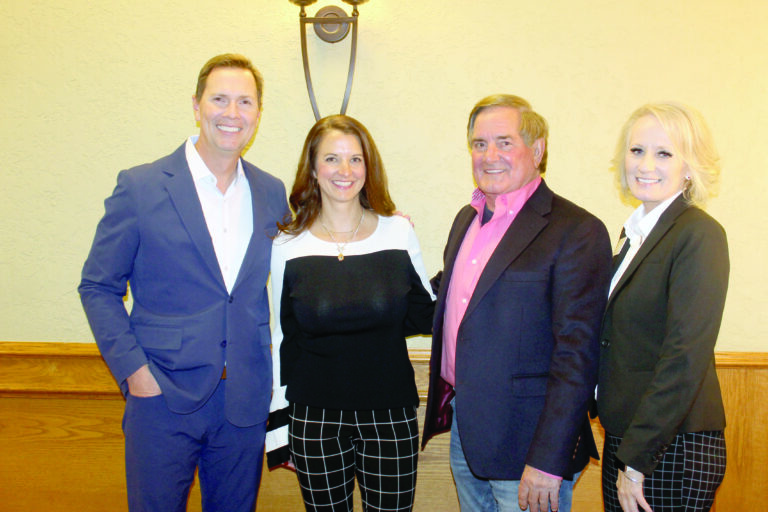Proposed CAFOs ruffle residents’ feathers
200 attend Pierce City meeting
BY SHEILA HARRIS [email protected]
Concerned residents of Lawrence and Newton Counties are bringing attention to what they believe is a lack of adequate regulation for Concentrated Animal Feeding Operations (CAFOs), poultry operations in particular.
About 200 people attended a public hearing hosted by the Missouri Department of Natural Resources (DNR) in Pierce City Thursday night. Over 20 residents spoke in opposition to seven permit applications for Class 1C poultry CAFOs proposed for sites in Lawrence and Newton Counties. Their concerns ranged from the degradation of water quality to the devaluation of their property.
The two gentlemen who spoke in favor of the proposed permits — a representative for Missouri Farm Bureau and an attorney representing the Missouri Pork and Cattlemen’s Associations — cited statistics about the positive impact of poultry production on Missouri’s economy, and suggested that concerns about a negative impact on ground and surface water quality in the Ozarks were nothing but fear-mongering.
The event was moderated by DNR’s Water Pollution Section chief, Heather Peters.
Newton County resident Tom Heidlage said his farm west of Wentworth will be surrounded by four of the CAFOs if the proposed permits are approved by the DNR — one within a half-mile of his house. He isn’t happy about the prospect.
“It isn’t like they’re just putting in one chicken house,” Heidlage said. “They’re talking six or eight houses per farm, on four farms.”
According to the DNR’s website, four applications have been submitted for Newton County properties near Heidlage’s farm, which, if approved, represent a total of 26 chicken houses within a roughly three-mile area, with a capacity for housing over 1,300,000 birds at a time.
An additional 16 chicken houses are proposed for three farms in an approximate two-mile area along Farm Road 2200 east of Monett, in Lawrence County. If approved, the permits will bring the total number of chicken houses with- in the approximate twomile stretch to 18, with a total capacity for housing 873,000 birds at any one time.
That’s too high of a concentration in a relatively small area,” Tom Heidlage said.
Missouri law does not currently limit the number of poultry houses that can be built within a prescribed area.
Heidlage is concerned about the amount of water that will be used by so many chicken houses in such close proximity.
“Our well went dry a couple of years ago during a drought, so I suspect it could happen again,” Heidlage said.
Heidlage is also concerned about a negative impact on the quality of his and his neighbors’ well water.
“The land’s not very solid around here,” he said, referencing the numerous sinkholes, mine shafts and losing streams in the area that, according to hydrologists, can allow contaminants to easily sink into the groundwater in the karst topography.
Results of geohydrologic surveys performed by the Missouri Geological Survey for the properties in question reveal that, because of karst features at each of the seven proposed CAFO sites, “significant potential for groundwater contamination” exists.
David Brittenham, a retired broiler grower for Tyson Foods, who operated south of Monett, believes neighbors’ concerns about groundwater contamination are for naught.
“A geohydrological survey doesn’t necessarily mean anything if the survey is done on the farms where they are building the chicken houses, unless that’s where the chicken litter (manure) is going to be spread,” Brittenham said. “A [grow-out] poultry operation is a dry litter operation. Pollution doesn’t just run out of the doors on a poultry house and soak into the ground, which is how the public has been led to view it.
“The only time anything that could pollute water comes out of poultry houses is when they are cleaned out, typically once a year.”
Even then, Brittenham said, the litter is typically exported from the farms for land-application as fertilizer somewhere else before it can pollute anything on the grow-out farm.
“If the goal of a geohydrological survey is to protect water quality, the survey needs to be conducted where the litter is spread,” Brittenham said.
In the case of the seven proposed CAFOs in Lawrence and Newton Counties, plans call for the exportation of litter to undesignated locations for land application.
Missouri law does not require the disclosure of locations where exported chicken litter will be land-applied, Peters said.
“We have requirements for land application on fields under the full operational control of the CAFO, but not for litter that is given away to other third-party farmers,” she said.
Nor, said Peters, is there land-application regulatory authority for dry poultry waste.
“The statute for land application of manure that is exported to third-party farmers establishes setback limits, but only for liquid manure that is surface applied,” she said.
An environmental group, Protect Our Water, Environment and Resources (POWER), is seeking to close that regulatory loophole, and, as their name suggests, protect the quality of groundwater in the Ozarks. They are represented by environmental attorney, Stephen Jeffery, with the Jeffery Law Group in St. Louis, who spoke at Thursday’s public hearing. Jeffery, on POWER’s behalf, submitted a letter to Kurt Schaefer, director of the DNR on May 27, asking for an amendment to Missouri’s 10 CSR 20-6.300 (“The Rule”).
The three-part requested amendment calls for prohibiting the issuance of permits for Class 1A, 1B and 1C CAFOs and the land application of waste in areas that have karst features, or where there is significant potential for groundwater contamination.
A second proposed addition to the law asks that CAFOs constructed within two miles of existing or other new proposed operations, and are under the same or affiliated ownership or management, be considered as one operation for the purposes of legal Classification.
“The scope of existing CAFO regulations in Missouri provides an incentive to intentionally construct smaller Class 1C [poultry] facilities in order to avoid the regulatory requirements applicable to larger Class [1B and 1C] facilities,” Jeffery’s letter states.
The difference between smaller Class 1C CAFO operations and larger Class 1A operations boils down to more red tape and a higher cost of doing business, Jeffery said.
“In general terms, [larger] Class 1A CAFOs have greater buffer distances, greater neighbor notice requirements, greater reporting requirements, require a wastewater permit, require certified operators, and require an odor control plan,” Jeffery said. “All the foregoing cost money.”
Jeffery’s letter on behalf of POWER also requests that a third addition to the law be made, one which would uphold the spirit of a law enacted by the Missouri General Assembly in 2013 (SB9, 442.571 RSMo), which limits foreign ownership of agricultural property to no more than 1% of total acreage in Missouri.
POWER’s requested addition includes language requiring that information be provided to the DNR “concerning the citizenship and nationality of applicants, shareholders, directors and members of LLCs, corporations or other organizations and all persons who own at least a 5% interest” in the operation of the farms.
Jeffery asked that the DNR hold in abeyance their decision on the proposed CAFO permits until the Missouri legislature has an opportunity to review and act upon POWER’s request for the three-part amendment.
A copy of Jeffery’s letter was sent to State Sen. Jill Carter, R-Granby; State Sen. Mike Moon, R-Ash Grove; State Rep. Scott Cupps, R-Shell Knob; and State Rep. Dirk Deaton, R-Noel.





